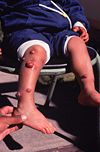
Carrion's disease
Encyclopedia
Oroya fever or Carrion's Disease is an infectious disease
produced by Bartonella bacilliformis
infection.
It is named for Daniel Alcides Carrión
.
 Carrion's disease has been known since Pre-Inca times. Numerous artistic representations in clay (called "huacos") of the chronic phase have been found in endemic areas. The Spanish chronist, Garcilazo De La Vega described a disease with warts in Spanish troops during the conquest of Inca Empire, in Coaque-Ecuador. For a long time it was thought that the disease was endemic only in Peru and that it had only one phase, the "Peruvian wart" or "verruga peruana"
Carrion's disease has been known since Pre-Inca times. Numerous artistic representations in clay (called "huacos") of the chronic phase have been found in endemic areas. The Spanish chronist, Garcilazo De La Vega described a disease with warts in Spanish troops during the conquest of Inca Empire, in Coaque-Ecuador. For a long time it was thought that the disease was endemic only in Peru and that it had only one phase, the "Peruvian wart" or "verruga peruana"
In 1875 an outbreak, characterized by fever and anemia occurred in the region of construction of the railroad line between Lima
and Oroya
. This is the source of the name "oroya fever" sometimes used to describe acute bartonellosis.
In August 1885, Daniel Alcides Carrión
, a Peruvian medical student, inoculated himself with material taken from a verruga lesion of a chronic patient (Carmen Paredes), with the help of a local physician (Evaristo Chavez). After 3 weeks he developed classic symptoms of the acute phase of the disease, thus establishing a common etiology
(cause) for these two diseases. He died from bartonellosis on October 5th, 1885 and was recognized as a martyr of Peruvian medicine and the term Carrión's Disease was used until our times (Peruvian Medicine Day is October 5 in honor to him).
Alberto Barton
, a Peruvian microbiologist, identified Bartonella bacilliformis within erythrocytes in 1905, an announced the discovery of the etiologic agent (Barton bacillus) in 1909, which was called Bartonella bacilliformis.
, Ecuador
, and Colombia
. It is endemic
in some areas of Peru
and is caused by infection with the bacterium Bartonella bacilliformis
and transmitted by sandflies
of genus
Lutzomyia
.
Acute phase: (Carrion's disease) the most common findings are fever (usually sustained, but with temperature no greater than 102°F (39°C)), pallor, malaise, nonpainful hepatomegaly, jaundice, lymphadenopathy, splenomegaly. This phase is characterized by severe hemolytic anemia and transient immunosuppression. The case fatality ratios of untreated patients exceeded 40% but reach around 90% when opportunistic infection with Salmonella spp occurs. In a recent study the attack rate was 13.8% (123 cases) and the case-fatality rate was 0.7%.
 Chronic phase: (Verruga Peruana or Peruvian Wart) it is characterized by an eruptive phase, in which the patients develop a cutaneus rash produced by a proliferation of endothelial cells and is known as "Peruvian warts" or "verruga peruana". Depending of the size and characteristics of the lesions, there are three types: miliary (1-4 mm), nodular or subdermic and mular (>5mm). Miliary lesions are the most common.
Chronic phase: (Verruga Peruana or Peruvian Wart) it is characterized by an eruptive phase, in which the patients develop a cutaneus rash produced by a proliferation of endothelial cells and is known as "Peruvian warts" or "verruga peruana". Depending of the size and characteristics of the lesions, there are three types: miliary (1-4 mm), nodular or subdermic and mular (>5mm). Miliary lesions are the most common.
The most common findings are bleeding of verrugas, fever, malaise, arthralgias, anorexia, myalgias, pallor, lymphadeopathy, and hepato-splenomegaly.
 Diagnosis during the acute phase can be made by obtaining a peripheral blood smear with Giemsa stain, Columbia-blood agar cultures, immunoblot, IFI, and PCR. Diagnosis during the chronic phase can be made using a Warthin-Starry stain of wart biopsy, PCR, and immunoblot.
Diagnosis during the acute phase can be made by obtaining a peripheral blood smear with Giemsa stain, Columbia-blood agar cultures, immunoblot, IFI, and PCR. Diagnosis during the chronic phase can be made using a Warthin-Starry stain of wart biopsy, PCR, and immunoblot.
s (such as ciprofloxacin
) or Chloramphenicol
in adults and Chloramphenicol plus beta lactams in children.
For the chronic phase, Rifampin or macrolide
s are used to treat both adults and children.
Infectious disease
Infectious diseases, also known as communicable diseases, contagious diseases or transmissible diseases comprise clinically evident illness resulting from the infection, presence and growth of pathogenic biological agents in an individual host organism...
produced by Bartonella bacilliformis
Bartonella bacilliformis
Bartonella bacilliformis is a proteobacterium, Gram negative aerobic, pleomorphic, flagellated, motile, coccobacillary, 2–3 μm large and 0.2–0.5 μm wide and facultative intracellular bacterium.-History:...
infection.
It is named for Daniel Alcides Carrión
Daniel Alcides Carrión
Daniel Alcides Carrión García was a Peruvian medical student after whom Carrion's disease is named. He described the disease in the course of what proved to be a fatal experiment upon himself in 1885, in order to demonstrate definitively the cause of the illness...
.
History

In 1875 an outbreak, characterized by fever and anemia occurred in the region of construction of the railroad line between Lima
Lima
Lima is the capital and the largest city of Peru. It is located in the valleys of the Chillón, Rímac and Lurín rivers, in the central part of the country, on a desert coast overlooking the Pacific Ocean. Together with the seaport of Callao, it forms a contiguous urban area known as the Lima...
and Oroya
Oroya
Oroya is a genus of cacti , originating from Peru....
. This is the source of the name "oroya fever" sometimes used to describe acute bartonellosis.
In August 1885, Daniel Alcides Carrión
Daniel Alcides Carrión
Daniel Alcides Carrión García was a Peruvian medical student after whom Carrion's disease is named. He described the disease in the course of what proved to be a fatal experiment upon himself in 1885, in order to demonstrate definitively the cause of the illness...
, a Peruvian medical student, inoculated himself with material taken from a verruga lesion of a chronic patient (Carmen Paredes), with the help of a local physician (Evaristo Chavez). After 3 weeks he developed classic symptoms of the acute phase of the disease, thus establishing a common etiology
Etiology
Etiology is the study of causation, or origination. The word is derived from the Greek , aitiologia, "giving a reason for" ....
(cause) for these two diseases. He died from bartonellosis on October 5th, 1885 and was recognized as a martyr of Peruvian medicine and the term Carrión's Disease was used until our times (Peruvian Medicine Day is October 5 in honor to him).
Alberto Barton
Alberto Barton
Alberto Barton, was a Peruvian microbiologist who discovered the etiologic agent of Carrion´s disease or Oroya fever. The bacteria was named: Bartonella bacilliformis, in his honor.-Youth and education:...
, a Peruvian microbiologist, identified Bartonella bacilliformis within erythrocytes in 1905, an announced the discovery of the etiologic agent (Barton bacillus) in 1909, which was called Bartonella bacilliformis.
Epidemiology
Carrion's disease is found only in PeruPeru
Peru , officially the Republic of Peru , is a country in western South America. It is bordered on the north by Ecuador and Colombia, on the east by Brazil, on the southeast by Bolivia, on the south by Chile, and on the west by the Pacific Ocean....
, Ecuador
Ecuador
Ecuador , officially the Republic of Ecuador is a representative democratic republic in South America, bordered by Colombia on the north, Peru on the east and south, and by the Pacific Ocean to the west. It is one of only two countries in South America, along with Chile, that do not have a border...
, and Colombia
Colombia
Colombia, officially the Republic of Colombia , is a unitary constitutional republic comprising thirty-two departments. The country is located in northwestern South America, bordered to the east by Venezuela and Brazil; to the south by Ecuador and Peru; to the north by the Caribbean Sea; to the...
. It is endemic
Endemic (epidemiology)
In epidemiology, an infection is said to be endemic in a population when that infection is maintained in the population without the need for external inputs. For example, chickenpox is endemic in the UK, but malaria is not...
in some areas of Peru
Peru
Peru , officially the Republic of Peru , is a country in western South America. It is bordered on the north by Ecuador and Colombia, on the east by Brazil, on the southeast by Bolivia, on the south by Chile, and on the west by the Pacific Ocean....
and is caused by infection with the bacterium Bartonella bacilliformis
Bartonella bacilliformis
Bartonella bacilliformis is a proteobacterium, Gram negative aerobic, pleomorphic, flagellated, motile, coccobacillary, 2–3 μm large and 0.2–0.5 μm wide and facultative intracellular bacterium.-History:...
and transmitted by sandflies
Sandfly
thumb|Sandfly biting a human's little fingerthumb|Sandfly biteSandfly is a colloquial name for any species or genus of flying, biting, blood-sucking Dipteran encountered in sandy areas...
of genus
Genus
In biology, a genus is a low-level taxonomic rank used in the biological classification of living and fossil organisms, which is an example of definition by genus and differentia...
Lutzomyia
Lutzomyia
Lutzomyia is a genus of "sand flies" in the Psychodidae subfamily Phlebotominae and in the order Diptera. In the New World, Lutzomyia sand flies are responsible for the transmission of leishmaniasis, an important parasitic disease and Carrion's disease. Leishmaniasis is generally transmitted in...
.
Clinical signs and symptoms
The clinical symptoms of bartonellosis are pleomorphic and some patients from endemic areas may be asymptomatic. The two classical clinical presentations are the acute phase and the chronic phase, corresponding to the two different host cell types invaded by the bacterium (red blood cells and endothelial cells).Acute phase: (Carrion's disease) the most common findings are fever (usually sustained, but with temperature no greater than 102°F (39°C)), pallor, malaise, nonpainful hepatomegaly, jaundice, lymphadenopathy, splenomegaly. This phase is characterized by severe hemolytic anemia and transient immunosuppression. The case fatality ratios of untreated patients exceeded 40% but reach around 90% when opportunistic infection with Salmonella spp occurs. In a recent study the attack rate was 13.8% (123 cases) and the case-fatality rate was 0.7%.

The most common findings are bleeding of verrugas, fever, malaise, arthralgias, anorexia, myalgias, pallor, lymphadeopathy, and hepato-splenomegaly.
Diagnosis

Treatment
The drug of choice during the acute phase is QuinoloneQuinolone
The quinolones are a family of synthetic broad-spectrum antibiotics. The term quinolone refers to potent synthetic chemotherapeutic antibacterials....
s (such as ciprofloxacin
Ciprofloxacin
Ciprofloxacin is a synthetic chemotherapeutic antibiotic of the fluoroquinolone drug class.It is a second-generation fluoroquinolone antibacterial. It kills bacteria by interfering with the enzymes that cause DNA to rewind after being copied, which stops synthesis of DNA and of...
) or Chloramphenicol
Chloramphenicol
Chloramphenicol is a bacteriostatic antimicrobial that became available in 1949. It is considered a prototypical broad-spectrum antibiotic, alongside the tetracyclines, and as it is both cheap and easy to manufacture it is frequently found as a drug of choice in the third world.Chloramphenicol is...
in adults and Chloramphenicol plus beta lactams in children.
For the chronic phase, Rifampin or macrolide
Macrolide
The macrolides are a group of drugs whose activity stems from the presence of a macrolide ring, a large macrocyclic lactone ring to which one or more deoxy sugars, usually cladinose and desosamine, may be attached. The lactone rings are usually 14-, 15-, or 16-membered...
s are used to treat both adults and children.

